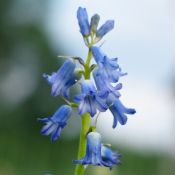



Nijssen Tuin & Bulbs Heemstede | Official site of Peter C. Nijssen




Intro: 1601. Origin: Pyrenees, north-eastern Spain and north-western former Yugoslavia. Brimeura looks something like a miniature 'Blue Bell'. Its semi-erect bright green leaves are narrow. Each leafless flower stalk develops a spike with many hanging and tubular blue flowers. Striking are the long pointed bracts that face the flower stem. Great for naturalising.